| SNAFFLES VS. LEVERAGE BITS |
|
There are three basic types of bitting devices; snaffles, gag bits and leverage bits. Snaffle bits are direct reining devices which lay across the horse's tongue through which the horse is directly guided, or "direct reined". Snaffle bits are used primarily for lateral control of the horse. Gag bits are somewhat similar to snaffles except that the horse will "lean" into the gag. Gags are used for racing and the only purpose of mentioning them here is that they are closely similar to snaffles, thus it is possible through improper use of a snaffle to turn the snaffle into a gag and encourage the horse to run away. (It is my belief that such misuse feeds the incorrect rumor that a rider can't stop a strong horse that is wearing a snaffle bit.) Leverage bits are devices where the reins are not directly connected to the mouthpiece. They are instead attached to shanks that hang down from the horse's mouth. Pulling the reins causes the bit to become a compound leverage device that applies pressure to the horse's jaw at a ratio much higher than the actual "pulling force" that is applied to the reins by the rider. |
The Importance of TermsMuch of this advice is often appropriate for one particular situation, but inappropriate in others. Therefore it's extremely important that we all understand and use the same terms. When "up" doesn't sometimes mean "down" and "snaffle bit" doesn't sometimes mean "leverage bit," the advice we give and receive will actually have some consistent relevance, and both horses and handlers will benefit. |
| Pictured right are two types of snaffles. The top is called a "full cheek snaffle". The outside bars prevent the bit from slipping horizontally through the horse's mouth. Full cheek snaffles are often used with younger horses who may shake their heads or pull laterally with their mouths open causing the bit to slip out of position. The lower snaffle has egg butt rings. Note how the reins attach and control the horse along the same plane as the mouthpiece. Both of these snaffles have broken (hinged) mouthpieces so that the mouthpiece can lay properly over the tongue. |
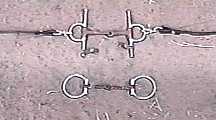
|
|
A curb chain can be attached to each ring on the snaffle. The chain acts much the same as the full cheek bars as it passes under the horse's jaw and will keep the bit from sliding through the mouth. Switching from a full cheek to a ring snaffle with a curb chain when working outside the arena minimizes the possibility of the horse getting a snaffle cheek bar caught on objects such as water troughs when riding out on trail. |
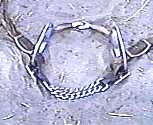
|
|
There is a common myth that all bits with broken mouthpieces are snaffles and
vice versa. Snaffles can be of "straight bar" design, such as with this old
draft horse driving bit. Additionally some leverage bits have broken
mouthpieces and therefore are not snaffles.
Horses have a variety of differently shaped mouths. The mouthpiece needs to be long enough to fit in the horse's mouth without pinching the lips, but not overly long where it will shift back and forth excessively. Additionally, some horses have rather flat pallets and they may need a flatter profile, 3-piece mouthpiece (one where the bar is "broken" in two places). |
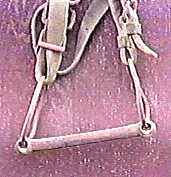
|
| The headstall should be adjusted so that the snaffle hangs comfortably in the horse's mouth, not so sloppy that it bumps the horse's teeth and not so tight that it applies uncomfortable pressure against the corners of the mouth. Generally if the snaffle pulls one to two mild wrinkles back against the corner of the mouth, the snaffle will maintain a comfortable position. |
| Leverage devices are finishing bits and are not suitable for training beginning horses since one of the first things the trainer needs to establish in the horse is lateral flexion and lateral control (being able to lightly bend the horse's neck and body and control his direction to left and right.) Leverage devices such as curb bits cannot be effectively "direct reined". Pulling on one rein to guide the horse will cause the lever to actuate and squeeze the jaw. Thus the horse must be taught to "neck rein" before wearing such a device and the curb should not be used to teach lateral control to a beginning horse. |
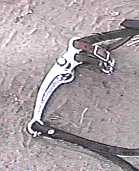
|
|
The severity of the curb is based on the ratio of length of the rein shank to chain shank according to the following formula:
-------------- (divided by) -------------- The pivot point to where the curb chain is attached at the end of the short shank
A curb with a 5" rein shank and a 1" curb shank will generate a
force ratio of 5:1. Thus a 20 lb. pull on the rein will result in 100 lbs. of
pressure being developed by the curb's "vise grip" onto the horse's jaw.
|
| There is often confusion surrounding the Tom Thumb bit. Often mistakenly called a "Tom Thumb snaffle" due to its broken mouthpiece, this device is really a short shanked leverage bit. Folks today think the name "Tom Thumb" suggests the bit is mild however the bit was named after a locomotive on the Baltimore and Ohio Railroad with the same name; a small locomotive that was for it's time the most powerful engine of its size in existence. (It was also the engine that lost the famous horse vs. locomotive race in 1830. It was well ahead when it threw a drive belt and stalled!) |

|
| The combination of the broken mouthpiece and leveraged rein attachment can make the Tom Thumb a most severe bit. The broken bit and lever can squeeze the jaw like a nut cracker. Some horses have had their jaws broken as a result of heavy handed riders who didn't realize the power of the Tom Thumb. If you use, or are contemplating using this bit please read The Trouble with Tom Thumb by Mark Rashid. He mistakenly refers to the Tom Thumb bit as a "snaffle," but otherwise his article is dead-on. |
Mechanical HackamoreAnother leverage device is the mechanical hackamore. This device is a modern adaptation of the ancient middle-eastern "haqima," which originally looked more like the bosal. The mechanical hackamore applies pressure across the bridge of the horse's nose and in the wrong hands can result in a broken nose. The one pictured here has 8" shanks. A 20 lb. pull on the reins will result in a 160 lb. force applied across the rather narrow cartilage which makes up the bridge of the horse's nose, which is why this particular device keeps permanent residence on display on our "Wall of Shame." |
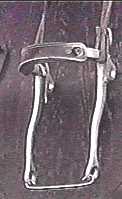
|
|
The snaffle is best handled when "direct reined." This means you will hold one rein in each hand. Your objective is to maintain just enough pressure to keep the bit lightly pressed against the horse's tongue. This amount of pressure will be comfortable to the horse and if you are practiced at maintaining light pressure, the horse will eventually respond and be "light" himself in order to maintain that point of comfort. How much contact should you have? There should be no excess slack yet you should have enough contact that you can feel the horse swallow. To do this, your hands and arms must be "fluid" and move with the horse's head. To guide the horse to the right, simply take up slack with the right rein while giving slack to the left. To guide the horse to the left, simply do the reverse. The amount of "bend" you get in the horse's neck can be adjusted by the amount of pressure which remains in your slack or opposite rein. For example, if you draw back with the left rein and give complete slack with the right rein, the horse's neck should bend sharply to the left and the horse's body should follow suit. However if you draw back with the left rein and only give a little slack with the right, the horse's neck and body will remain more rigid and he will tend to pivot more over his hind legs (haunches) and swing to make the turn rather than bend his body through it. Schooling horses involves asking the animals to bend to various degrees of lateral pressure along with "shaping" their bodies and generating momentum and directing the horse's feet by means of various leg aids. Young and inexperienced horses need to be able to capably bend to varying degrees so the use of a direct reining device such as a snaffle bit is very important.
Do you remember the discussion about gag bits and race horses? If your horse is forging forward and you pull back evenly with both reins your snaffle will easily lock against the horse's molars and become a gag. Like the race horse, your horse can lean against a gag and gain momentum. Thus, to stop your horse you do not want to pull back evenly with both reins. A more effective means of communicating with your horse is to relax in your seat and "stop riding" with your body while you draw back on one rein while holding your original position with the other. Such action will prevent the snaffle from "locking" into a gag and if you need to, you can give a slight tug-tug-tug with the "active" rein to regain your horse's attention if his mind has gone somewhere else, and you can then aid him into a safe stop. To help your horse become more proficient in stopping in a snaffle bit, please see Seven Steps to Safer Horsemanship by Frank Bell. Continue to Mecate ReinsPress "Back" to return to the page that brought you hereReturn to Training SectionReturn to Case Study SectionReturn to Wild Horse MentorsReturn to KBR World of Wild Horses and BurrosGo To
|

